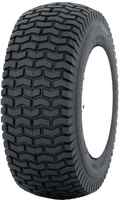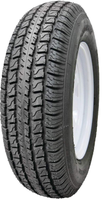Bias Tire Size
You probably know that tires feature either a bias ply build or a radial one. But what are bias ply tires? When should you choose them over radial ones? Let's see why most heavy duty tires have a bias structure.
Primarily, plies are an essential component of the tire. They are the internal layers that give a tire its shape and upgrade its durability and load capacity. These layers can consist of various materials such as thin steel cables, kevlar, nylon, or other durable stuff. Also, they are fused together with different rubber compounds, creating a sheet that is the finished ply.
So, what exactly is a bias ply construction?
Often called a diagonal build, it features a criss-cross arrangement of plies, usually at a 35 to 40 degree angle to the center line. The structure makes the tire less flexible because the sidewall and crown plies are not separate. This means that a thick ply layer envelops the tire as a whole, making it more durable. One reason why they are an excellent choice for heavy duty jobs is the high puncture resistance.
Now, let's go over some of the pros and cons of a bias build.
Starting off, the tire is very tough and has strong sidewalls that offer protection from various hazards. It is also good for rugged terrains and heavy loads, making it suitable for construction sites and farmlands. On the other hand, bias tires often overheat faster than radial ones due to the thick layers. They also do not efficiently absorb bumps because the sidewalls aren't that flexible.
The most popular Bias Tire brands
As we've mentioned above, bias tires are mostly suitable for agricultural and industrial applications, where durability and load capacity are more important than speed and comfort. When choosing a high quality bias tire, you should consider some of the following brands: BKT, Titan, Galaxy, Primex, Goodyear, and Mitas. Of course, there are plenty of other trusted manufacturers that specialize in bias tires, however, you can be sure to never go wrong when selecting these names. Moreover, some brands such as Mickey Thompson use a bias ply construction for drag racing tires to benefit from the sidewall wrinkle that absorbs some of the impact and power sent to the wheels.
You probably know that tires feature either a bias ply build or a radial one. But what are bias ply tires? When should you choose them over radial ones? Let's see why most heavy duty tires have a bias structure.
Primarily, plies are an essential component of the tire. They are the internal layers that give a tire its shape and upgrade its durability and load capacity. These layers can consist of various materials such as thin steel cables, kevlar, nylon, or other durable stuff. Also, they are fused together with different rubber compounds, creating a sheet that is the finished ply.
So, what exactly is a bias ply construction?
Often called a diagonal build, it features a criss-cross arrangement of plies, usually at a 35 to 40 degree angle to the center line. The structure makes the tire less flexible because the sidewall and crown plies are not separate. This means that a thick ply layer envelops the tire as a whole, making it more durable. One reason why they are an excellent choice for heavy duty jobs is the high puncture resistance.
Now, let's go over some of the pros and cons of a bias build.
Starting off, the tire is very tough and has strong sidewalls that offer protection from various hazards. It is also good for rugged terrains and heavy loads, making it suitable for construction sites and farmlands. On the other hand, bias tires often overheat faster than radial ones due to the thick layers. They also do not efficiently absorb bumps because the sidewalls aren't that flexible.
The most popular Bias Tire brands
As we've mentioned above, bias tires are mostly suitable for agricultural and industrial applications, where durability and load capacity are more important than speed and comfort. When choosing a high quality bias tire, you should consider some of the following brands: BKT, Titan, Galaxy, Primex, Goodyear, and Mitas. Of course, there are plenty of other trusted manufacturers that specialize in bias tires, however, you can be sure to never go wrong when selecting these names. Moreover, some brands such as Mickey Thompson use a bias ply construction for drag racing tires to benefit from the sidewall wrinkle that absorbs some of the impact and power sent to the wheels.
Need live support?
- Mon - Fri: 8am - 7pm ET
- Sat: 9am - 5pm ET
- Sun: Closed







